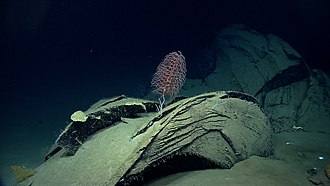Asphalt volcano
Asphalt volcano is the name for an up to 800 m high volcanic elevation on the ocean floor, which consists of salt and from the top of which natural asphalt emerges. The term asphalt volcanism was introduced without understanding the process of asphalt emergence - only the association of the asphalt with the crater and landslide structures and the morphological similarity of the asphalt layers with igneous lava flows has led to this. The asphalt currents, which have been trodden and hardened on the seabed, are, like ʻAʻā lava, fissured by numerous cracks and crevices.
This geological feature was discovered by an international group of researchers led by the University of Bremen on board the research ship " Sonne " in 2003. The researchers were made aware of the location through images from satellites showing traces of oil on the surface of the water.
The geology of asphalt volcanism
At the bottom of Campeche Bay at a depth of around 3000 m , in the southern part of the Gulf of Mexico northwest of the Mexican state of Campeche on the Yucatán peninsula , there are diapir-shaped salt domes , locally called Campeche Knolls (Campeche hills), from the tips of which natural asphalt emerges and flows down the slopes like lava.
Until this discovery, only small areas covered with asphalt had been observed, but an area of over 1 km 2 was discovered in Campeche Bay . In this marine region, salt deposits deposited during the Jurassic period push up from a depth of 8–15 km to above the level of the sea basin floor, while the asphalt arises from crude oil that has been decomposed and thermally modified by microorganisms. The Campeche Knolls , about 5 to 10 km wide at their base, are between 450 and 800 m high and of various shapes ( morphology ), most of them are elongated ridges , some have a round, dome-like shape. The slope is between 10 and 20%. One of the most closely investigated asphalt volcano was 'named after from the Aztec language family by its discoverers, Chapopote Nahuatl -derived word Chapopote or the them in the Mexican Spanish borrowed chapapote , both meaning, asphalt'.
A new kind of ecosystem
The existence of chemosynthetic ( chemotrophic ) organisms has long been known, for example from the submarine black smokers found along the mid-ocean ridges . There, the rising hot sulphurous solutions serve as a source of energy, while the asphalt fulfills this function in the Campeche Knolls' unique ecosystem . It is the basis of large accumulations of chemosynthetic bacteria and mussels from the Vesicomyidae family, as well as beard worms , which act as sea indicators and are indicators of leaking fluids; crustaceans and fish have also been observed. The use of asphalt as a source of food is unusual and, in this form, a new phenomenon for science, because it represents the final stage in the conversion of petroleum and is therefore not considered to be very life-friendly. Exactly which chemical compounds are used by the organisms for chemosynthesis is still unclear, as is the exact ecological relationships within this habitat.
The leader of the expedition , Prof. Gerhard Bohrmann , commented on the discovery: “As a researcher you rarely have the opportunity to discover completely unknown things. On earth this is only possible in the deep sea. "
Asphalt volcanoes in the Santa Barbara Canal, California

In 2007, during bathymetric mapping with sonar probes , dome-shaped hills were discovered on the sea floor of the Santa Barbara Channel , California , at a water depth of approximately 220 meters. Further investigations with submersibles by scientists from the University of California, Santa Barbara showed that these consist almost exclusively of asphalt.
There are crude oil production sites near the asphalt volcanoes. The crude oil extracted from the Monterey Formation there has the same chemical composition as the asphalt from the volcanoes. The researchers' trips revealed that no oil wells were active underwater in 2010. In some places, however, methane escaped in small amounts .
The asphalt found was formed around 40,000 years ago. The cones formed at the outlets have been removed by the currents in the canal since the Ice Age. Today only the recently discovered hills are preserved. In 2010 no clear, unanimous opinion was found about the origin of the submarine leaks.
literature
- MacDonald, IR et al .: Asphalt Volcanism and Chemosynthetic Life in the Campeche Knolls, Gulf of Mexico. Science, Vol. 304, pp. 999–1002, 14 May 2004 (PDF file; 564 kB)
Web links
- Christopher Joyce: Ocean Asphalt Patch a Deep-Seep Mystery. All Things Considered, May 14, 2004 National Public Radio (English)
- Andrea Naica-Loebell: "Beware, the deep sea is freshly tarred" - asphalt volcanoes discovered on the seabed of the Gulf of Mexico. Telepolis , May 16, 2004
- Weekly Scientific Reports from the Sun: 5th Weekly Report (October 31 - November 6, 2003) . Federal Institute for Geosciences and Raw Materials
- Dossier asphalt volcanoes at scinexx , November 3, 2006


